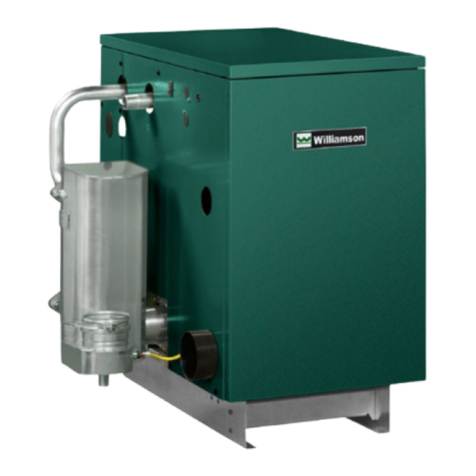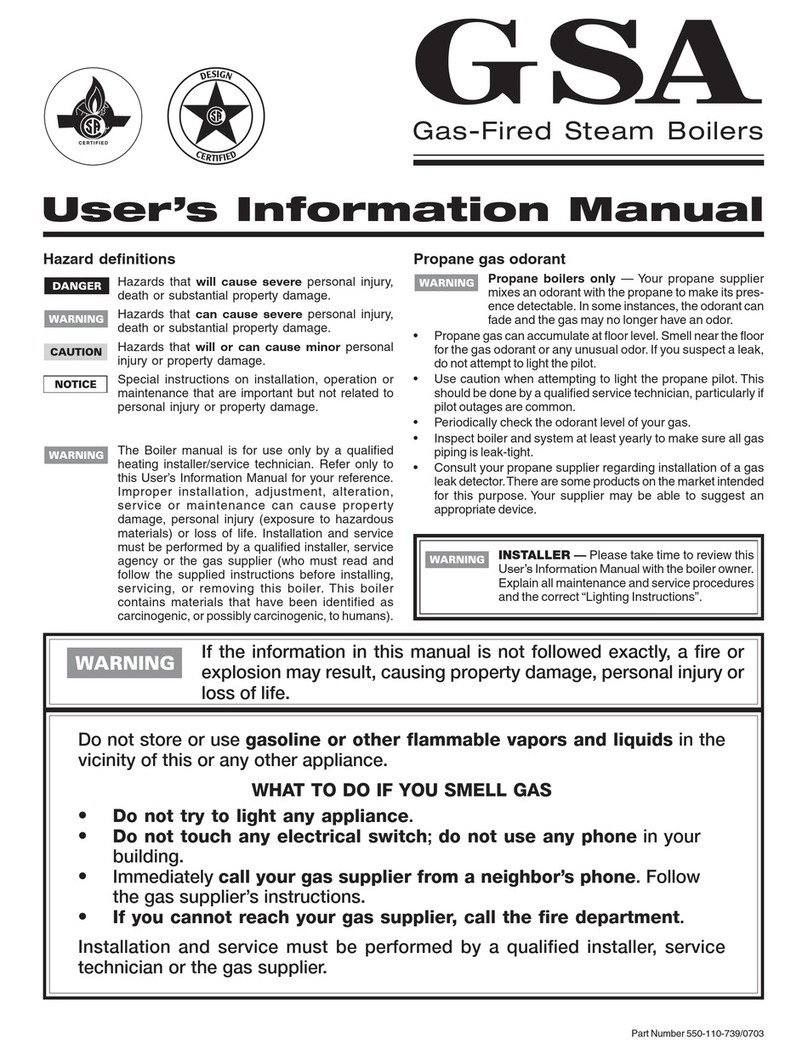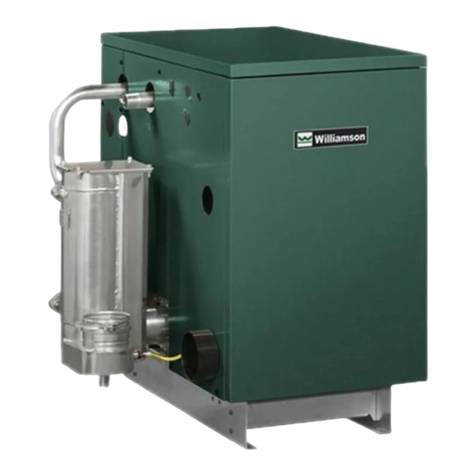
GWS-090E
Gas-Fired Water Boiler – Boiler Manual
4Part Number 550-110-737/1108
1 Prepare boiler location continued
Failure to followall instructionscanresultin flue gas
spillage and carbon monoxide emissions, causing
severe personal injury or death.
DonotinstalltheGWS-090Eintoacommonvent
with any other appliance. This will cause flue gas
spillage or appliance malfunction, resulting in pos-
sible severe personal injury, death or substantial
property damage.
GWS-090Eboilerscanonlybedirect-ventvented.
They cannot be chimney-draft vented or direct-ex-
haustvented.SeeGWSVentingManualfordetailed
installation instructions.
If you are removing an existing boiler from a shared
ventingsystem,theGWS-090Eboilercannotshare
theventsystem(itrequiresitsownvent).Youmust
test each appliance remaining on the old common
vent system individually to verify the vent system
still operates adequately. Follow guidelines below.
When removing boiler from existing common vent
system:
Atthetimeofremovalofanexistingboiler,thefollowingsteps
shall be followed with each appliance remaining connected to
the common venting system placed in operation, while the other
appliances remaining connected to the common venting system
are not in operation.
a. Seal any unused openings in the common venting system.
b. Visually inspect the venting system for proper size and hori-
zontal pitch and determine there is no blockage or restriction,
leakage,corrosionor other deficiencieswhichcouldcausean
unsafe condition.
c. Test vent system — Insofar as is practical, close all building
doors and windows and all doors between the space in which
the appliances remaining connected to the common venting
system are located and other spaces of the building. Turn
on clothes dryers and any appliance not connected to the
common venting system.Turn on any exhaust fans, such as
range hoods and bathroom exhausts, so they will operate at
maximumspeed.Donotoperatea summerexhaustfan.Close
fireplace dampers.
d. Place in operation the appliance being inspected. Follow the
lighting/operatinginstructions.Adjustthermostatsoappliance
will operate continuously.
e. Test for spillage at draft hood relief opening after 5 minutes of
mainburneroperation.Usetheameofamatchorcandle.
f. Afterithasbeendeterminedthateachapplianceremaining
connectedtothecommonventingsystemproperlyventswhen
testedasoutlinedabove,returndoors,windows,exhaustfans,
fireplace dampers, and any other gas-burning appliance to
their previous conditions of use.
Any improper operation of common venting system should be
corrected so the installation conforms with the National Fuel
GasCode,ANSIZ223.1–latestedition.Correctbyresizingto
approach the minimum size as determined using the appropriate
tables in Part 11 of that code.Canadian installations must comply
with B149.1 or B149.2 Installation Code.
GWS-090E special vent system required
Vent system
TheGWS-090Eboilerrequiresaspecialventsystem,designed
forpressurizedventing.ModelGWS-090EisratedANSIZ21.13
Category IV (pressurized vent, likely to condense in the vent).
You may use any of the direct vent systems (combustion air
ducted to boiler) covered in GWSVenting Manual included in
the boiler envelope assembly.The GWS vent starter is a special
item,designedonlyforGWSandGWS-90E,availablefromeach
vendor.DonotattempttoconnecttheventtoaGWS-090Eboiler
with any other means.
DO NOT mix components from different systems.
The vent system could fail, causing leakage of flue
products into the living space.
Vent termination and combustion air supply
TheGWS-090Eboilermaybeventedthroughtherooforthrough
asidewall.FollowtheappropriateinstructionsintheGWSVenting
Manualfortheventsystemchosen.Themaximumventlength
depends on boiler size. Refer to the GWSVenting Manual to
determine acceptable vent length.
CombustionairfortheGWS-090Eboilermustbeducteddirectly
to the boiler from outside. For outside air (direct vent installa-
tion), two options are available for the flue/air termination. The
air supply must ALWAYS terminate at the same location as the
flue, using either:
1. Vertical direct vent installation — Obtain theThrough-Roof or
Through-UnusedChimneyTerminationKit.RefertotheGWS
VentingManual,packedwiththekitandtotheventmanufac-
turer’sinstructionsfortheventmaterialchosen.
2. Sidewall direct vent installation — Use theVent/Air Intake
Termination Kit shipped with the boiler. Refer to the GWS
VentingManualshippedwiththeboiler.
Vent system



































